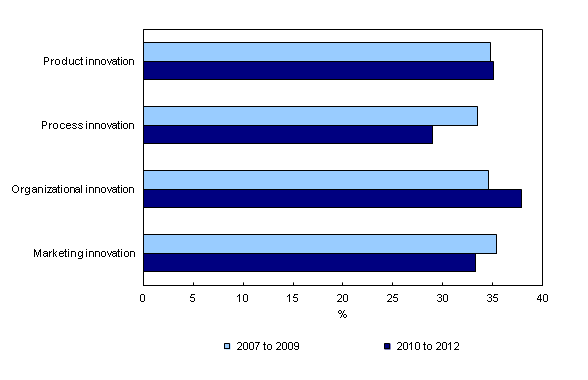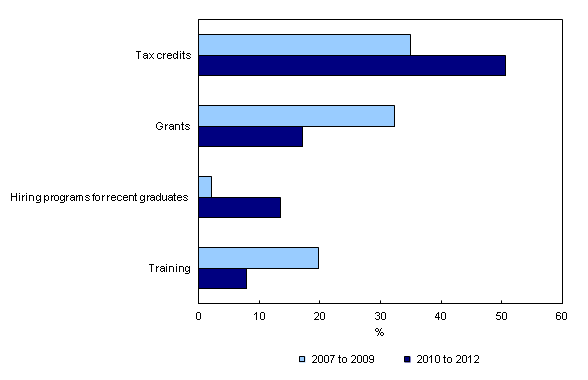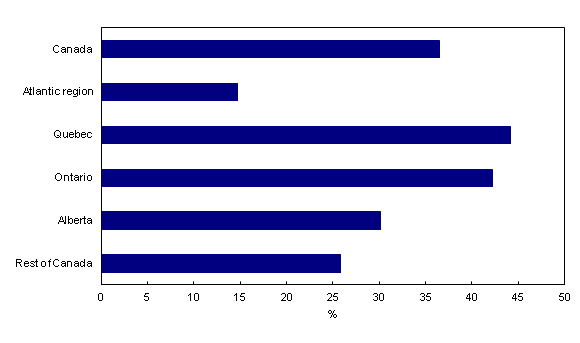Survey of Innovation and Business Strategy, 2012
Archived Content
Information identified as archived is provided for reference, research or recordkeeping purposes. It is not subject to the Government of Canada Web Standards and has not been altered or updated since it was archived. Please "contact us" to request a format other than those available.
Released: 2014-02-14
Innovation in Canada
Between the three-year periods of 2007 to 2009 and 2010 to 2012, the percentage of enterprises that introduced at least one type of innovation went from 66.8% to 63.5%.
Process innovation — the implementation of new or significantly improved production processes or distribution and delivery methods — declined the most. It fell from 33.5% for the 2007 to 2009 period to 29.0% for 2010 to 2012. In contrast, organizational innovation — the introduction of new or significantly improved business practices such as supply chain management, lean production, new methods of organizing work responsibilities, decision-making or external business relationships — increased the most, rising from 34.6% to 37.9%.
This shift towards organizational innovation may reflect enterprises choosing to reduce their costs by optimizing current operations through reorganization rather than by introducing new logistics, distribution or production methods.
During the 2010 to 2012 period, enterprises continued to introduce new or significantly improved products at a similar rate compared with 2007 to 2009, and maintained the introduction of new or significantly improved marketing methods and sale channels for promotion and generation of sales. Product innovators — enterprises that introduced new or significantly improved products — went from 34.8% in 2007 to 2009 to 35.1% in 2010 to 2012, while marketing innovators went from 35.4% to 33.3%.
Innovation in Canada by enterprise size
Innovation decreased in all of the enterprise size groups. The largest decrease occurred in medium-sized enterprises, where the percentage of innovative enterprises fell from 76.3% for the 2007 to 2009 period to 60.1% for 2010 to 2012. Large enterprises declined from 74.7% to 70.8%, while small enterprises were down from 64.9% to 63.5%.
Regional perspective on innovation in Canada
At the national level, during the 2010 to 2012 period, enterprises in professional, scientific and technical services (77.1%), manufacturing (74.8%) and finance and insurance (73.6%) had the highest rates of innovation. Transportation and warehousing (55.9%), mining, quarrying and oil and gas extraction (56.3%) and wholesale trade (56.7%) saw the lowest rates.
Ontario had the highest proportion of innovative enterprises during the 2010 to 2012 period at 71.2%, followed by Alberta (62.1%), Quebec (60.9%), the rest of Canada (58.7%) and the Atlantic provinces (45.8%). Regionally, enterprises by industrial sector had noticeably different rates of innovation.
In Ontario, almost all enterprises were innovative in administrative and support, waste management and remediation services (95.1%), followed by enterprises in professional, scientific and technical services (90.7%), and finance and insurance (77.9%).
Enterprises with the highest rate of innovation in Alberta were in information and cultural industries (81.8%), utilities (75.2%) and transportation and warehousing (74.1%) during the 2010 to 2012 period.
During the 2010 to 2012 period, innovative enterprises in manufacturing (82.6%) led all other sectors in Quebec and all other manufacturing enterprises in Canada (74.8%). For Quebec, enterprises in retail trade (73.9%) and information and cultural industries (73.2%) were the next two sectors most likely to be innovative.
Enterprises in Atlantic Canada with the highest levels of innovation were in information and cultural industries (90.1%), professional, scientific and technical services (70.3%), and finance and insurance (66.2%).
Tax credits: The most critical government program to support innovation
For the three-year period 2010 to 2012, half of all enterprises in surveyed industries determined that government tax credits were the most critical public program in support of their innovation activities. This is up from 34.9% in 2007 to 2009, when tax credits also led in importance of government support programs. This pattern of importance of government tax credits as the most critical public program in support of innovation activities occurred in all regions and firm sizes.
Government grants were the second most critical support program for both time periods, although their importance fell from 32.3% in 2007 to 2009 to 17.1% in 2010 to 2012.
In contrast, enterprises determined that the use of government hiring programs for recent graduates was now the third most critical government program in support of innovation activities, overtaking training programs that ranked third from 2007 to 2009.
Advanced technology use in Canada, 2012
Advanced technology use can support the innovation activities of enterprises. For example, the development or significant improvement of a product, process, marketing technique or organizational practice may be related to the use of advanced technology. Types of advanced technology use studied include: computerized design and engineering; computerized processing; fabrication and assembly; computerized inspection; communication; automated material handling; information integration and control technologies; biotechnologies/bioproducts; nanotechnologies; and green technologies.
In 2012, 36.5% of enterprises in all surveyed industries used at least one type of advanced technology. This is down from 49.9% in 2009. This decrease in the use of advanced technology occurred across all surveyed sectors. Most notable declines by type of advanced technology use occurred in advanced communication and green technologies.
Advanced technology use varied across industrial sectors in 2012, with enterprises in utilities (65.1%), professional, scientific and technical services (58.9%) and manufacturing (53.1%) leading in the use of at least one advanced technology. Advanced computerized design and engineering was the most important type of advanced technology used in these three sectors.
In contrast, the industrial sectors least likely to use an advanced technology in 2012 were retail trade (15.9%); real estate and rental and leasing (23.6%); and construction (29.3%). Again, advanced computerized design and engineering use led for real estate and rental and leasing and construction, while advanced computerized inspection technologies and advanced information integration and control technologies use tied for first in retail trade.
Large enterprises most likely to use advanced technology
Overall, large enterprises were the most likely to use at least one advanced technology in 2012 at 48.7%, followed by medium-sized enterprises (43.6%) and small enterprises (34.7%). For large enterprises, the top three most important advanced technologies used were communication (30.2%); computerized design and engineering (27.2%) and information integration and control (24.3%).
In 2012, advanced technology use in order of importance for medium-sized and small enterprises was similar to that of large enterprises, although for both medium-sized and small enterprises, computerized design and engineering led, followed by communication and computerized processing, fabrication and assembly.
Advanced technology use: A regional perspective
In 2012, Quebec (44.2%) and Ontario (42.2%) were the leaders with enterprises using at least one type of advanced technology, while enterprises in the Atlantic region (14.7%) lagged in advanced technology use. The choice of advanced technology use across the regions showed little variance, with computerized design and engineering and communication technologies appearing in the top three for each region.
Note to readers
The 2012 Survey of Innovation and Business Strategy (SIBS) is a joint initiative of Statistics Canada; Industry Canada; the Department of Foreign Affairs, Trade and Development; the Atlantic Canada Opportunities Agency; Institut de la statistique du Québec; the Ontario Ministry of Economic Development and Trade and Employment and the Ontario Ministry of Research and Innovation; and Alberta Innovation and Advanced Education.
SIBS 2012 provides key information on strategic decisions, innovation activities and operational tactics used by Canadian enterprises. Innovation data are collected for a three-year period. For SIBS 2012, the three-year period was 2010 to 2012 while for the previous iteration of SIBS (2009), the three-year period was 2007 to 2009.
The SIBS 2012 sample was composed of 7,818 enterprises in Canada with at least 20 employees and revenues of $250,000 or more. These enterprises spanned 14 sectors within the North American Industry Classification System (2007). In 2012, the sample was stratified into five regions: the Atlantic region; Quebec; Ontario; Alberta; and the rest of Canada; the previous SIBS (2009) was not stratified by region. For Canada, the sample was also stratified by industry groups and by enterprise size: small (20 to 99 employees); medium (100 to 249 employees) and large (250 or more employees). Data collection for the 2012 reference period was undertaken between March and August 2013.
SIBS 2012 estimates are provided as percentages accompanied by quality indicators. Data quality indicators are based on the standard error (SE) and number of observations in the estimates. Quality indicators for SIBS are the following:
A is very reliable (SE between 0% and 2.49%);
B is reliable (SE between 2.50% and 7.49%);
E is use with caution (SE between 7.50% and 14.99%); and
F is too unreliable to be published (SE greater than or equal to 15.00%).
Definitions
Innovative: the implementation of a new or significantly improved product (good or service), or process, or a new marketing method, or a new organisational method in business practices, workplace organisation or external relations.
Product innovation: the market introduction of a new or significantly improved good or service with respect to its capabilities, user friendliness, components or sub-systems.
Process innovation: the implementation of a new or significantly improved production process, distribution method, or support activity for goods or services.
Marketing innovation: the implementation of a new marketing concept or strategy that differs significantly from the enterprise's existing marketing methods and that has not been used before.
Organisational innovation: new organizational method in the enterprise's business practices (including knowledge management), workplace organization or external relations that has not been previously used by the enterprise.
This is the first of three planned releases from the 2012 Survey of Innovation and Business Strategy. The next release will be on global value chains and obstacles to exporting. The third release is dedicated to business strategy.
Contact information
For more information, contact us (toll-free 1-800-263-1136; 514-283-8300; infostats@statcan.gc.ca).
To enquire about the concepts, methods or data quality of this release, contact Louise Earl (613-951-2880) or Marc Nadeau (613-951-3692), Investment, Science and Technology Division.
- Date modified:




